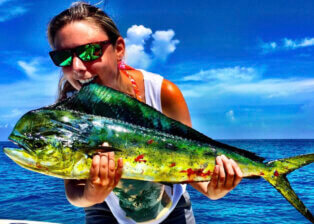Florida Keys Mahi Fishing – Light Tackle & Conventional Tactics for Dorado
Florida Keys Mahi Fishing offers one of the most exciting offshore adventures in the sport. The Mahi Mahi, also known as Dorado in Spanish, is prized for its electric colors, fast runs, and incredible acrobatics. From May through October, these pelagic fish migrate through our waters, giving anglers the chance to enjoy some of the best offshore fishing in the world.

Our offshore grounds range from 150 feet to 1,500 feet of water, with the warm Gulf Stream delivering ideal conditions. Between the abundant bait, diverse offshore structure, and skilled captains who know how to find them, it’s no wonder the Florida Keys are a premier Mahi fishing destination.
Finding Mahi in the Florida Keys
Successful Florida Keys Mahi Fishing means knowing what to look for:
-Floating Structure – Logs, pallets, or other debris act like fish magnets, drawing in baitfish and the Mahi that feed on them.
-Sargasso Weedlines – Golden mats of Sargassum create natural shelter and feeding zones that can stretch for miles.
-Bird Activity – Working Frigate birds or Man-o-War birds diving on baitfish are a sure sign Mahi are feeding below.
Light Tackle Mahi Fishing
For anglers who love a hands-on, sporting fight:
-Rods – 15–20 lb class custom spinning rods from Randy Towe of Islamorada Fishing Outfitters.
-Reels – Shimano Saragosa 5000–8000 series spooled with 20–30 lb braid.
-Leader – 4–6 ft of 30–40 lb fluorocarbon.
-Baits & Lures – Live pilchards, cigar minnows, ballyhoo, trolling feathers, Mahi jigs, and chuggers.
Conventional Tackle for Big Bulls
When targeting trophy Mahi during Florida Keys Mahi Fishing trips:
-Rods – 20–30 lb class trolling or stand-up rods.
-Reels – Shimano Talica 16 or 20, paired with braid and a mono topshot.
-Spread Setup – Rigged ballyhoo on flat lines, skirted baits on outriggers, teasers, and dredges to draw fish in.
Baits & Trolling Strategy
Our go-to trolling bait for Mahi is fresh rigged ballyhoo. When we want to add flash and color, we’ll pair the ballyhoo with skirts for extra attraction. We also run small artificial squid baits we affectionately call Squid-Jiggies, which Mahi can’t resist.
When trolling through working birds or over floating structure, the moment we hook a Mahi, we keep that fish in the water near the boat. This tactic keeps the entire school in sight — sometimes more than 50 fish — swimming in the crystal-clear blue water around us. From there, we switch to live bait or cut ballyhoo and squid, hooking fish after fish until the school finally moves on. On a good day, it’s not unusual to catch dozens of Mahi from a single school.
The Fight
Mahi are known for their blistering runs and high-flying leaps. On light tackle, steady pressure and a high rod tip help control their jumps. On conventional gear, let the drag do the work while watching for sudden surges near the boat.
Seasonal Patterns
-May–June – Larger bulls and cows arrive first.
-July–August – Peak action for schoolies in the 5–15 lb range.
-September–October – A mix of slammers and schools with fewer boats around.
Record Mahi
-Florida State Record – 81 lbs, caught off Lantana in June 2007.
-IGFA All-Tackle World Record – 88 lbs (39.91 kg), caught in Exuma, Bahamas in 1998. The IGFA (International Game Fish Association) is the official authority on world fishing records.
Why the Keys are Mahi Central
With deep blue waters, rich currents, and unmatched local knowledge, Florida Keys Mahi Fishing offers non-stop action, visual excitement, and incredible table fare. Whether you want to fight a bull on light tackle or load the fish box trolling, this is offshore fishing at its best.
 IntelligenceStorm
IntelligenceStorm